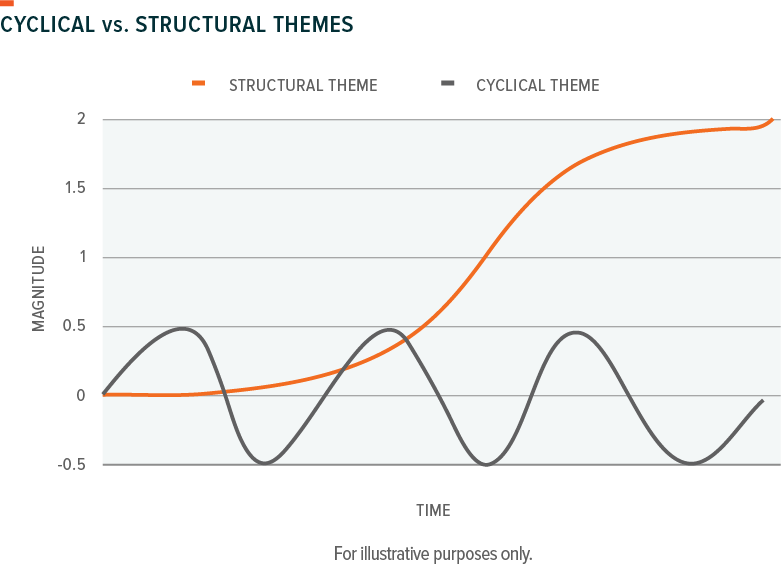Investors are increasingly taking a thematic approach to investing by considering powerful macro-level trends and their potential impact on the returns of various investments. We believe it’s important, however, to distinguish between two fundamentally different types of themes given their different characteristics.
- Cyclical Themes: occur at somewhat regular short or medium term intervals, typically based on changes in the business cycle. These cyclical trends can be mean-reverting, so that over a long period of time they tend to converge with some average level. Examples can include asset valuations, volatility, interest rates, and currency values.
- Structural Themes: occur as one-off shifts that change an existing paradigm. These structural changes tend to be longer term in nature and are typically driven by powerful forces such as disruptive technologies or changing demographics and consumer behavior.

Some areas can be affected by both cyclical and structural trends. Employment levels, for example, can cyclically fluctuate with the economy, as employment typically suffers in recession and benefits from expansion. Structural trends in employment can also occur, such as declining workforce participation rates due to an aging population.
Technology firms can similarly be affected by both cyclical and structural trends. On the cyclical side, tech firms demonstrate sensitivity to economic growth, benefitting from increased personal and business spending. Tech can also participate in structural trends, such as driving advancements in robotics and artificial intelligence that are expected to have a far reaching impact on industrial manufacturing processes, transportation, health care, and other segments of the economy.
We believe long term investors should prioritize identifying structural themes rather than cyclical ones. Given the longer term nature of these themes and their disruptive nature, we have found that structural themes can be less dependent on timing entry and exit points and can be significantly more powerful in magnitude.
Related ETFs
- BOTZ: Global X Robotics & Artificial Intelligence ETF seeks to invest in companies that potentially stand to benefit from increased adoption and utilization of robotics and artificial intelligence (AI), including those involved with industrial robotics and automation, non-industrial robots, and autonomous vehicles.
- LIT: The Global X Lithium & Battery Tech ETF invests in the full lithium cycle, from mining and refining the metal, through battery production.
- SNSR: Global X Internet of Things ETF seeks to invest in companies that stand to potentially benefit from the broader adoption of the Internet of Things (IoT). This includes the development and manufacturing of semiconductors and sensors, integrated products and solutions, and applications serving smart grids, smart homes, connected cars, and the industrial internet.
 Global X Research Team
Global X Research Team